On 12th April 1944 the crew of this 432 Squadron Halifax took off from East Moor airfield at 14.20hrs to undertake an air to air firing exercise and a fighter affiliation exercise both over the North Sea off the Yorkshire coast. With the firing exercise concluded the crew return inland towards their base. The aircraft was flying at a low height over the Langdale area with the air speed indicator unserviceable when one of engines also failed. The aircraft passed roughly over the top of Backleys Farm, pulled up to avoid the North Head ridge, it then lost height quickly, probably because the pilot was trying to find somewhere to force land and had notice reasonably flat fields behind Deepdale Farm. The crash investigators believed that the pilot had lost height to around fifty feet to make a landing but had then realised that Deepdale Farm was in his path so made a tight turn to avoid the house. With no air speed indicator and a faulty engine controlling the aircraft must have been difficult. In making a steep turn and probably at a lower flying speed that the pilot thought, the aircraft stalled, struck a tall tree and crashed. The crash appears to have been first reported to police at Scarborough who informed Pickering police who then informed Wombleton airfield. A guard on the site appears to have been placed on the site by members of No.66 BSD, RASC probably based at Birch Hall then a guard from Wombleton airfield took over. Six of the seven airmen on board were killed with the survivor remarkably escaping with only minor injuries who was taken to Scarborough Hospital with shock, burns and hand injuries. All the crew appear to have not been commissioned prior to the crash though some were later promoted after their deaths. The crash investigation could find no reason why the faulty engine had failed but they also found that the faulty engine and propeller was not feathered prior to the crash.
The crash site is now inside what is now part of the wider Dalby Forest area. In July 2004 I received a letter from Mrs M.Hick of Scarborough following a request I made in a local magazine for witnesses to accidents in the Hackness area, Mrs Hick's mother witnessed this accident. She recounted that the aircraft came over the hill from the east and crashed into the wooded area with the tail section falling off first (I would suggest that this saved the rear gunner from fatal injuries). Mrs Hick's mother had witnessed the crash from a nearby field while she was on her way back home from obtaining water from their well. The surviving airman saw her and asked if she was alright. She recalled that the aircraft had broken up across a stream and that the stream had aircraft fuel flowing down it. As with all such incidents, a guard was placed on the wreckage until it was cleared. In October 2014 I met with Mr Norman Kendall formerly of Freeze Gill Farm, Troutsdale (now of Egton). He was working in a field near Troutsdale Lodge when he saw the aircraft approaching with an engine believed to have been on fire, he believed that the pilot was attempting to find somewhere to put the aircraft down and had selected the field Mr Kendall was in because it was reasonably flat and long but on noticing the field had people in it the pilot pulled the aircraft up to avoid the wooded hillside of Backleys Wood. Mr Kendall saw the aircraft then flew over Backleys Farm very low and later heard it had then clipped a fence on the edge of a field north of this farm (on North Head) before crashing near Deepdale Farm.
Halifax LW614 was built to contract ACFT/1808/C4/C by English Electric Co.Ltd. at Samlesbury and was delivered directly to 431 'Iroquois' Squadron at Croft on 15th February 1944. 431 Squadron were operating Halifax B.V's at this period so the aircraft was immediately transferred to 432 Squadron at East Moor who were converting from Lancaster B.II's to Halifax B.III's in February 1944. It was written off following the incident detailed above, with Cat.E2/FA Burnt damage being the damage assessment recorded. Prior to this crash this aircraft had previously taken part in nine operational flights. This crew's last operational flight had been just two days before this accident when they successfuly attacked railyards at Ghent.
Pilot - P/O Arthur Kenneth Clarke RCAF (J/89944), aged 22, of Hawkstone, Simcoe County, Ontario, Canada. Buried Harrogate Stonefall Cemetery, Yorkshire.
Flight Engineer - Sgt Harvey Halliwell RAFVR (1523572), aged 20, of Middleton, Lancashire. Buried Middleton (St Leonard), Lancashire.
Navigator - P/O Thomas Harold Woodard RCAF (J/86325), aged 26, of Weyburn, Saskatchewan, Canada. Buried Harrogate Stonefall Cemetery, Yorkshire.
Bomb Aimer - Sgt Francis Edward Cranch RCAF (J/89914), aged 31, of Vancouver, British Columbia, Canada. Buried Tottenham and Wood Green Cemetery, London.
Wireless Operator / Air Gunner - Sgt Felix Campbell Hindmarsh RCAF (J/89248), aged 24, of Edam, Saskatchewan, Canada. Buried Edinburgh (Mount Vernon) Roman Catholic Cemetery.
Air Gunner - P/O David Gordon Bell RCAF (J/88695), aged 25, of Lower Capilano, British Columbia, Canada. Buried Harrogate Stonefall Cemetery, Yorkshire.
Aero Enginer Mechanic / Passenger - LAC David Victor MacKenzie RCAF (R/142262), aged 24, of Moose Jaw, Saskatchewan, Canada. Buried Harrogate Stonefall Cemetery, Yorkshire.
Rear Gunner - Sgt Donald Stuart Morrison MacNeil RCAF (R/207301). Survived with burns and a broken collar bone.
On 15th April 1944 a Roman Catholic Mass was held at East Moor for Sgt's Woodard and Hindmarsh, on 17th March 1944 a funeral service for F/Sgt Clarke and LAC McKenzie was held at Sutton on the Forest church after which the burials were carried out at Harrogate.

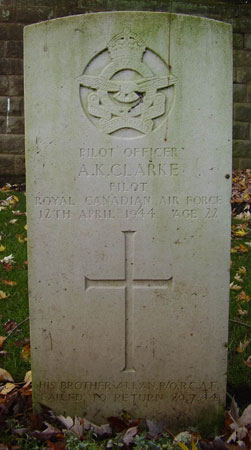
Arthur Kenneth Clarke and his headstone at Harrogate Stonefall Cemetery. Arthur was known by his second name Kenneth, he was born on 16th November 1921 in Hawkestone, Ontario, Canada and was one of a number of children born to James William and Mary (nee Wildmore) Clarke. His parents were married in Woodhall Spa, Lincolnshire in 1901 so probably moved to the Hawkestone area of Ontario not long after and set up farming at Sunnyside Farm, Hawkestone. After leaving school Kenneth initially worked for his father's transport buisness and then worked for a warehouse company in Toronto driving trucks before returning to the family buisness driving trucks and having a part ownership in the buisness. He enlisted for RCAF service in Hamilton on 21st February 1942 and after initial training in Canada was awarded his Pilot's Wings on 6th April 1943. He left Canada for the UK at the end of May 1943 and on arrival in the UK he continued his training at 15 (P)AFU (beginning 22nd June 1943), 18 (P)AFU (beginning 27th July 1943) and which here was attached to 1514 BAT Flight (beginning 10th August 1943) for a week. He was posted to 24 OTU on 7th September 1943, Dalton Battle School on 4th December 1944 and then to 1659 HCU on 8th January 1944. His crew at 1659 HCU contained Clarke, Woodard, Hindmarsh, MacNeil, Cranch, Halliwell but a different air gunner; Sgt Fred Andrew Burgess RCAF (R/192742) (Not David Gordon Bell). With his training completed Kenneth Clarke and his crew were posted to 432 Squadron on 11th February 1944. He was granted a commission to the rank of P/O on 11th April 1944, but this was granted after his death and back-dated.
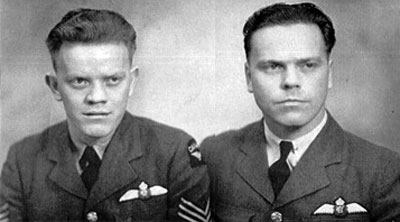
His older brother Edward Allan Clarke RCAF (J/86745) also served as a pilot in the RCAF and also with the same 432 Squadron. Sadly he lost his life on 29th July 1944 on his last operational flight of his tour flying in Halifax NP702 on Ops to Hamburg, the aircraft was lost without trace and he and his crew are commemorated on the Runnymede Memorial. The photograph above shows Arthur Kenneth Clarke on the left and Edward Allan Clarke on the right and was found on "http://rcafcentralia.blogspot.co.uk". As previously stated, Kenneth Clarke's regular air gunner Sgt Fred Burgess air gunner through training appears to have joined the crew of Edward Allan Clarke at 432 Squadron and was flying with him before Kenneth Clarke's aircraft crashed through to July 1944 when the aircraft failed to return. Other brothers Norman Lionel served in the RCAF and Merton Blakey Clarke served in the Canadian Navy.

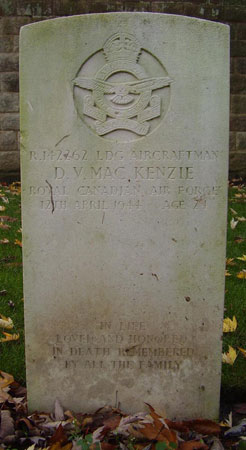
David Mackenzie and his gravestone. The photograph to the left was found on the Canadian Virtual War Memorial with whom I have contributed information regarding other casualties. David MacKenzie was born on 24th May 1940 in Leader, Saskatchewan and was the son of Robert Colin and Mary Marshall (nee Badger) MacKenzie. His father was born in Ireland and mother born in Scotland. After attending school in Saskatchewan he took a job ranching at Lundbreck, Alberta but later returned to Saskatchewan undertaking farmwork and breaking horses. He enlisted into the RCAF in Regina on 1st December 1941. His brother James Alexander MacKenzie served in the Royal Canadian Engineers and brother John Badger MacKenzie served in the RCAF as groundcrew. His father also served in the RCAF in WW2 as part of a maintenance unit. Having trained as an aero engine mechanic and initially serving in Canada David left to serve overseas, he sailed by boat from New York to the UK arriving on 11th January 1944. He was posted to 432 Squadron on 9th February 1944.
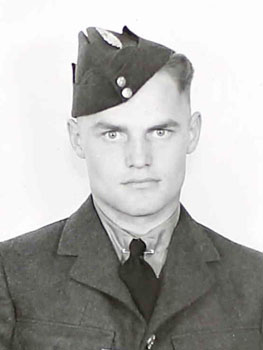
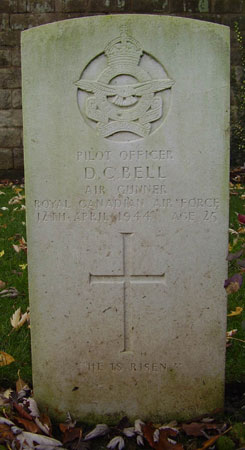
David Bell was born on 26th March 1919 at his family's ranch at Grand Forks, British Columbia, Canada and was the son of George Alexander and Constance Mary Bell. His father sadly died when he was just a few months old, he had formerly served in the Royal Navy from as early as 1890 as Fleet Surgeon retiring in 1910. A young David Bell attended the Charles Dickens School in Vancouver and as a young man he had been a gold miner and prospector in the Cariboo and Zeballos areas from 1936 to 1941 before working in a shipyard in Vancouver until enlisting for RCAF service. He enlisted in Vancouver on 13th October 1942. After completing basic training in Canada he was awarded his Air Gunner badge on 20th August 1943. On arrival in the UK he trained at 24 OTU from 28th September 1943 and after a spell at the Dalton Battle School and 1659 HCU he was posted to 432 Squadron on 10th February 1944. He was granted a commission to the rank of P/O after his death but back dated to 11th April 1944. He was not part of Arthur Clarke's crew that had trained together at 1659 HCU. He had an older brother P/O Edward Norman Bell (J/2458) served in the RCAF in WW2 and was made a PoW on 15th September 1943 while serving with 428 Squadron. He was flying as second pilot in Halifax LK913 undertaking an operational flight to bomb Montlucon, France when the aircraft was hit by incendiary bombs falling from an aircraft above his. His captain/pilot managed to crash land and all on board survived but four including him were taken PoW.
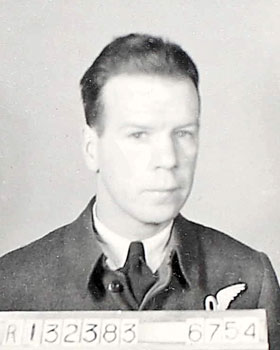
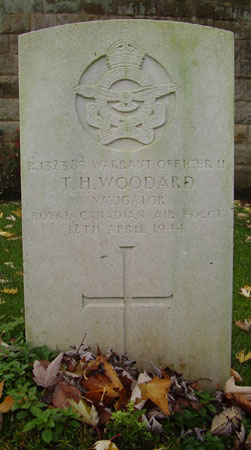
Thomas Woodard was born on 11th June 1915 in Weyburn, Saskatchewan, Canada and was the son of Archibald Joseph and Mary Mamie (nee Ratican) Woodard. As a young man he attended Souris school and Weyburn collegiate and completed a BComm from the University of Saskatchewan gaining a degree in chartered accountancy. He work working as an accountant when he enlisted into the RCAF in Regina on 29th October 1941. Having initially being selected for, and then starting, pilot training he switched to navigator training in September 1942. With training complete in Canada he was awarded his Naviagtor's Badge on 19th February 1943. On arrival in the UK in April 1943 he was eventually posted to 1 (O)AFU in July 1943 and 24 OTU in September 1943 where he probably joined what became the "Clarke" crew. He was then posted to the Dalton Battle School in December 1943 and then to 1659 HCU in January 1944. With the training courses complete the crew were posted to 432 Squadron on 10th February 1944. He too appears to have received a commission after his death but back-dated to 11th April 1944
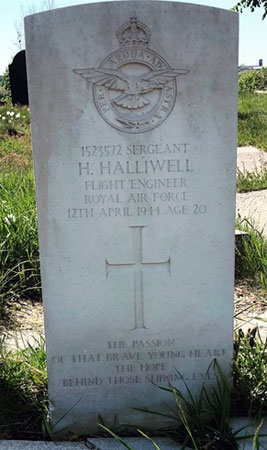
Harvey Halliwell's grave. I thank his relation Jan Jones for kindly supplying it for inclusion here.
Francis Cranch was born on 4th February 1913 in Winnipeg, Manitoba, Canada and was the son of Samuel Edward Andrew and Ann (nee Shaw) Cranch. His father was born in Devon, England and when Francis completed his attestation papers he stated that he was a seaman with an address as unknown. His mother was born in Longton (Staffordshire?), England. As a young man Francis trained as a carpenter and was working in boatbuilding for around ten years before the start of the War. His family had moved from Winnipeg to Vancouver before WW2. He initially attempted to enlisted into the RCAF in September 1939 but got on response so enlisted into the Canadian Army on 19th September 1939 instead in Vancouver. He was on active service with the 4th Signals Division in Canada when, as a L/Cpl, he left the Canadian Army and enlisted into the RCAF on 5th April 1942 in Halifax, Nova Scotia. He trained in Canada initially as a navigator but later switched to be a bomb aimer, he was awarded his Air Bomber's badge on 25th June 1943. On arrival in the UK in July 1943 he was posted to 6 (O)AFU on 10th August 1943, 24 OTU on 7th September 1943, Dalton Battle School on 4th December 1943 and then 1659 HCU to complete his flying training on 8th January 1944. He was then posted to 432 Squadron on 10th February 1944. These postings in England are exactly the same as David Bell's so I assume they were part of the same crew going through training together from 24 OTU to 432 Squadron. Francis married Gladys Doris Luff, of Barrington Road, Crouch End, London on 30th March 1944 in St.George's Church, Hornsey, Middlesex. Thirteen days later Francis was killed in the crash of Halifax LW614. She later emigrated to Vancouver and died in 2004. He too received a commission after his death to the rank of P/O, back dated to 11th April 1944.

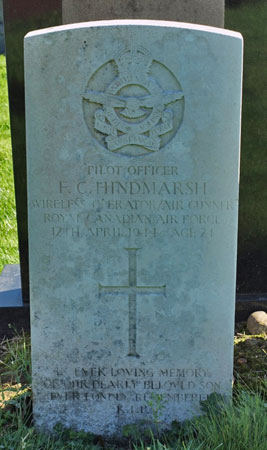

Felix Hindmarsh was born in Edinburgh, Scotland on 10th April 1920 and was the son of Andrew and Catherine (nee Lafferty) Hindmarsh. His father was born in Bedlington, Northumberland and his mother was born in Edinburgh. The family appear to have sailed to Canada in 1926 arriving in Quebec but setting up home in Edam, Saskatchewan, Canada where Felix attended school. As a young man he worked for C.N. Railways, Saskatchewan from 1938 to 1940 and then as a lathe operator for General Motors, in St.Catherines, Ontario from 1940. He enlisted into the RCAF in Toronto on 21st July 1941 and at that time was living in Merritton area of St.Catharines, Ontario. With training in Canada later completed he was posted overseas in July 1943 and continued his Bomber Command training at 9(O)AFU (beginning 3rd August 1943), 24 OTU (beginning 7th September 1943) and Dalton Battle School (beginning 4th December 1943) and later to 1659 HCU at Topcliffe during January 1944. He was posted to 432 Squadron on 10th February 1944 with the rest of Kenneth Clarke's crew. He was granted a commission after his death and back dated to 11th April 1944. Felix had two brothers who served in the Canadian forces during WW2. Andrew Hindmarsh served in England with the RCAF and flew with 408 Squadron while his brother Thomas served in the Canadian Army. His brother Andrew Hindmarsh erected a plaque on the Edam War Memorial in 1990 to commemorate Felix Hindmarsh. Andrew Hindmarsh died in January 1991 aged 69 years. His gravestone photograph was posted to the internet by "StephenC".
The survivor of Halifax LW614 was Donald MacNeil, he was initially admitted to Scarborough Hospital following the crash but was transferred directly to East Grinstead Hospital on 15th April 1944 for treatment to burns to his hands and face. He became one of the famous Guinea Pig patients.
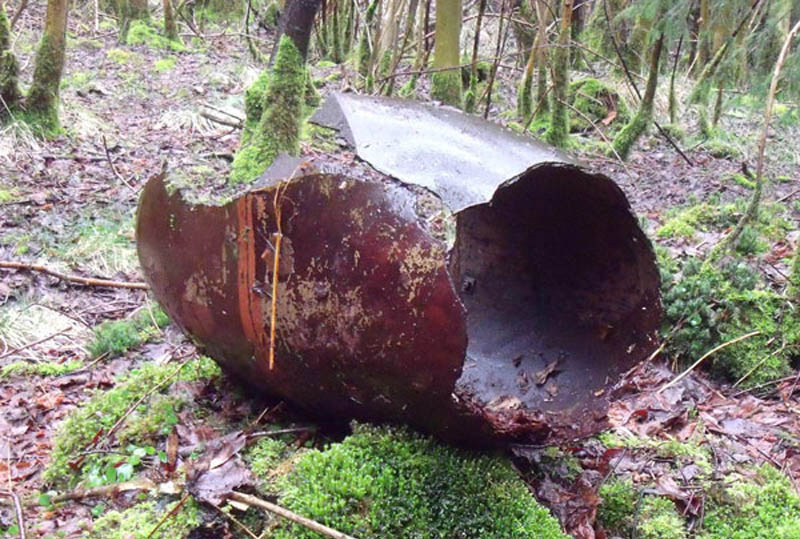
John Skinn and I first searched for the crash site in July 2004 and found only one piece of the aircraft but a large piece and a rare sight at a crash site. Initially dismissed as possibly farm rubbish after some cleaning Air Ministry markings were found on it which identified it as a large and remarkably intact section of the aircraft's bakerlite DF Loop casing (pictured above). The DF Loop is visible on the Halifax photograph at the top of this page, midway between the cockpit glazing and the mid-upper turret.
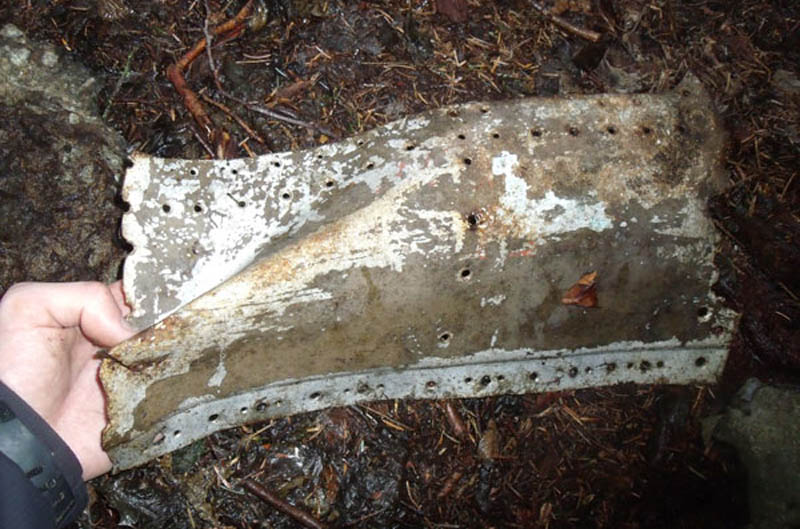
In May 2006 Howard Newbould and I visited the site and were able to locate further pieces of the aircraft which after correspondance from Mrs Hick were in the location which she recalled. I then returned to the site in March 2010 to re-photograph the parts previously located with a digital camera. The photograph above shows a piece of the aircraft's outer skin with the green/grey colour scheme still visible. I returned with Alan Clark and Mark Sheldon in January 2014 to re-photograph and survey the site more thoroughly.
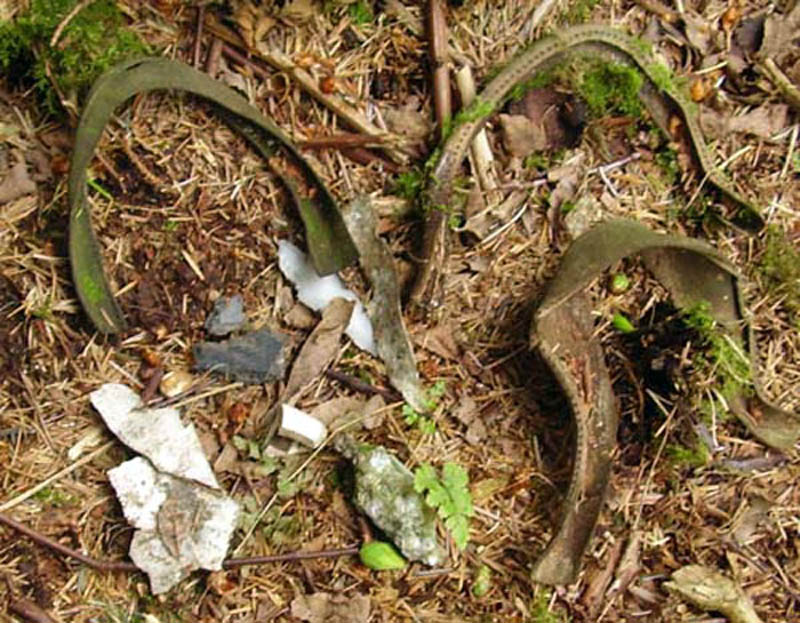
A small collection of remaining wreckage found in the stream in 2010.
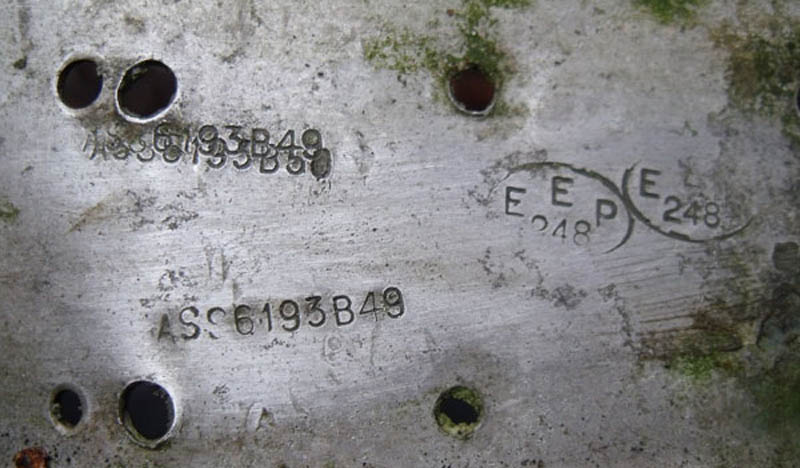
An English Electric inspection stamp located on one of the parts at the site in 2010. The other number seems to have been incorrectly stamped and an attempt has been made to overstamp it with the correct assembly number, with the same correct number being stamped underneath.
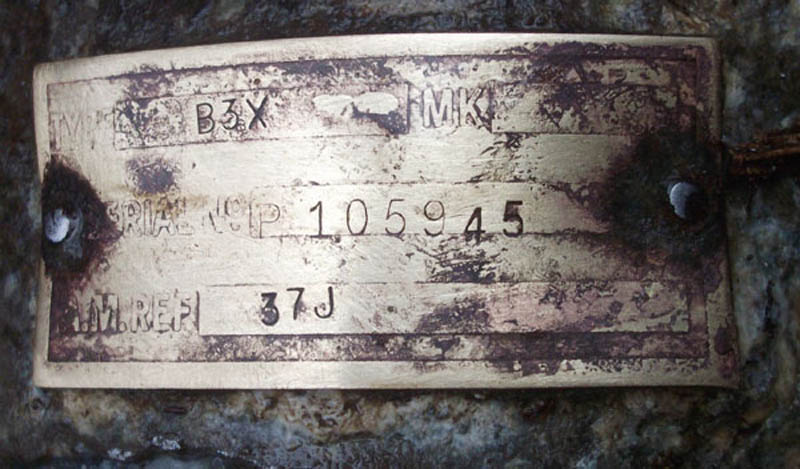
A brass plate attached to a pump found at the site in 2014.
I would like to express my thanks to Mrs M Hick and her sister for taking the time to write to me in 2004 and for recounting their memories of this incident. I would also like to thank Mr Norman Kendall for recounting his memories of this incident to me in 2014.